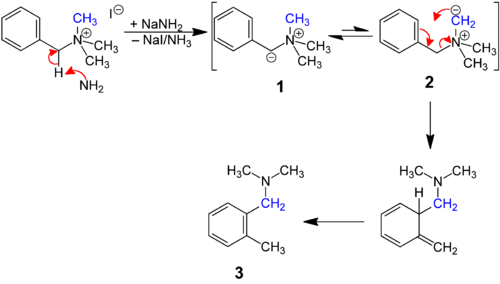Sommelet–Hauser rearrangement
The Sommelet–Hauser rearrangement (named after M. Sommelet[1] and Charles R. Hauser[2]) is a rearrangement reaction of certain benzyl quaternary ammonium salts.[3][4] The reagent is sodium amide or another alkali metal amide and the reaction product a N,N-dialkylbenzylamine with a new alkyl group in the aromatic ortho position. For example, benzyltrimethylammonium iodide, [(C6H5CH2)N(CH3)3]I, rearranges in the presence of sodium amide to yield the o-methyl derivative of N,N-dimethylbenzylamine.[2]
Mechanism
The benzylic methylene proton is acidic and deprotonation takes place to produce the benzylic ylide (1). This ylide is in equilibrium with a second ylide that is formed by deprotonation of one of the ammonium methyl groups (2). Though the second ylide is present in much smaller amounts, it undergoes a 2,3-sigmatropic rearrangement and subsequent aromatization to form the final product (3).[5]
The Stevens rearrangement is a competing reaction.
References
- ↑ M. Sommelet, Compt. Rend. 205, 56 (1937).
- 1 2 Rearrangements of Benzyltrimethylammonium Ion and Related Quaternary Ammonium Ions by Sodium Amide Involving Migration into the Ring Simon W. Kantor, Charles R. Hauser J. Am. Chem. Soc., 1951, 73 (9), pp 4122–4131 doi:10.1021/ja01153a022
- ↑ March, Jerry (1985), Advanced Organic Chemistry: Reactions, Mechanisms, and Structure (3rd ed.), New York: Wiley, ISBN 0-471-85472-7
- ↑ Organic Syntheses, Coll. Vol. 4, p.585 (1963); Vol. 34, p.61 (1954) Link.
- ↑ Ahluwalia, V. K., and R. K. Parashar. Organic Reaction Mechanisms. Harrow, U.K.: Alpha Science International, 2005. Print.

